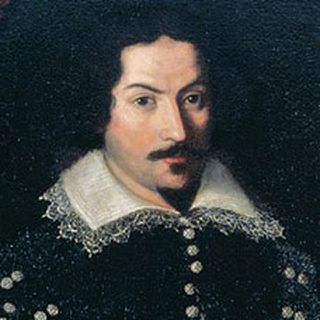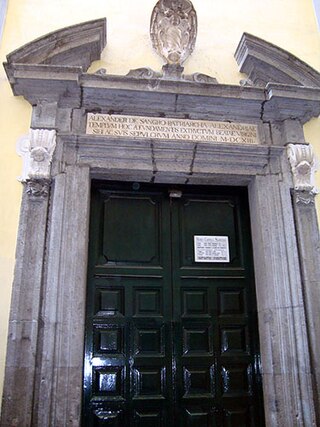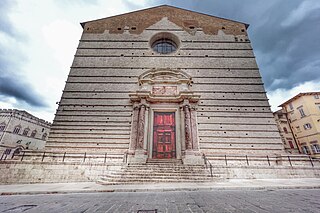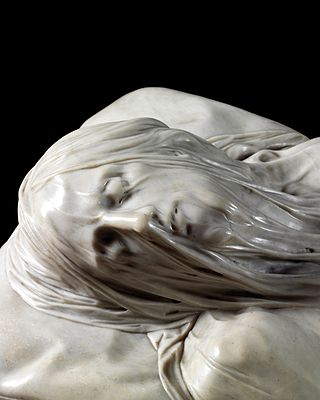History
A palace at the site was begun by Paolo di Sangro, duke of Torremaggiore in the 16th century as his family residence. It was designed by the sculptor and architect Giovanni da Nola. Around that time it was also resident to the nobleman and composer Carlo Gesualdo - it was here that he murdered his wife. Giovan Francesco Paolo di Sangro, 1st Prince of San Severo, began building a family burial chapel in the palace grounds - it was completed in 1613 by his son Alessandro, patriarch of Alexandria and archbishop of Benevento. Paolo de Sangro, 2nd Prince of San Severo, rebuilt the palace, especially the facade, with designs by Bartolomeo Picchiatti and with a portal entryway sculpted by Vitale Finelli.
The palace's peak came in the 18th century when Raimondo di Sangro, 7th Prince of San Severo, redesigned the interior of the chapel and palace and linked the two buildings with a passageway. A marble plaque on the facade commemorates his association with the palace. He began the works in 1735 and they were completed by his son Vincenzo in the 1790s. On the night of 28 September 1889 the passageway was flooded and collapsed.
The atrium has anthropomorphic sculptural decorations attributed to Giuseppe Sammartino and Francesco Celebrano. The mezzanine decorations of the Seasons are also attributed to Celebrano. The palace was once decorated with frescos by Belisario Corenzio, destroyed during the collapse of the hall.

Lodi is a city and comune in Lombardy, northern Italy, primarily on the western bank of the River Adda. It is the capital of the province of Lodi.

Vincenzo Scamozzi was an Italian architect and a writer on architecture, active mainly in Vicenza and Republic of Venice area in the second half of the 16th century. He was perhaps the most important figure there between Andrea Palladio, whose unfinished projects he inherited at Palladio's death in 1580, and Baldassarre Longhena, Scamozzi's only pupil.

Andrea Palladio was an Italian Renaissance architect active in the Venetian Republic. Palladio, influenced by Roman and Greek architecture, primarily Vitruvius, is widely considered to be one of the most influential individuals in the history of architecture. While he designed churches and palaces, he was best known for country houses and villas. His teachings, summarized in the architectural treatise, The Four Books of Architecture, gained him wide recognition.

The Collegio Clementino is a palace in Rome, central Italy, sited between the Strada del'Orso and the banks of the Tiber. It was founded by Pope Clement VIII in 1595, to host Slavonian refugees. Giacomo della Porta was commissioned to erect a suitable building to house them, which would be one of the aged architect's last projects. On February 25, 1601, Urban VIII shifted the Slavs to Loreto and refounded the Collegio Clementino as an elite school for young noblemen of every nation and the richest families in Rome. The musical tradition of the Collegio Clementino remained strong: Alessandro Scarlatti wrote oratorios for Carnival seasons and came up from Naples to oversee their production.

Carlo Maderno (Maderna) was an Italian architect, born in today's Ticino, who is remembered as one of the fathers of Baroque architecture. His façades of Santa Susanna, St. Peter's Basilica and Sant'Andrea della Valle were of key importance in the evolution of the Italian Baroque. He is often referred to as the brother of sculptor Stefano Maderno, but this is not universally agreed upon.

The Basilica of San Petronio is a minor basilica and church of the Archdiocese of Bologna located in Bologna, Emilia Romagna, northern Italy. It dominates Piazza Maggiore. The basilica is dedicated to the patron saint of the city, Saint Petronius, who was the bishop of Bologna in the fifth century. Construction began in 1390 and its main facade has remained unfinished since. The building was transferred from the city to the diocese in 1929; the basilica was finally consecrated in 1954. It has been the seat of the relics of Bologna's patron saint only since 2000; until then they were preserved in the Santo Stefano church of Bologna.

San Severo is a city and comune of c. 51,919 inhabitants in the province of Foggia, Apulia, Southern Italy. Rising on the foot of the spur of Gargano, San Severo adjoins the communes of Apricena in the north, Rignano Garganico and San Marco in Lamis in the east, Foggia and Lucera in the south, and Torremaggiore and San Paolo di Civitate in the west.

Antonio Corradini was an Italian Rococo sculptor from Venice. He is best known for his illusory veiled depictions of the human body, where the contours of the face and body beneath the veil are discernible.

The Cappella Sansevero is a chapel located on Via Francesco de Sanctis 19, just northwest of the church of San Domenico Maggiore, in the historic center of Naples, Italy. The chapel is more properly named the Chapel of Santa Maria della Pietà. It contains works of Rococo art by some of the leading Italian artists of the 18th century.

Sant'Anna dei Lombardi,, and also known as Santa Maria di Monte Oliveto, is an ancient church and convent located in piazza Monteoliveto in central Naples, Italy. Across Monteoliveto street from the Fountain in the square is the Renaissance palace of Orsini di Gravina.

Perugia Cathedral is a Roman Catholic cathedral in Perugia, Umbria, central Italy, dedicated to Saint Lawrence. Formerly the seat of the bishops and archbishops of Perugia, it has been since 1986 the archiepiscopal seat of the Archdiocese of Perugia-Città della Pieve.

San Paolo Maggiore is a basilica church in Naples, southern Italy, and the burial place of Saint Cajetan, founder of the Theatines. It is located on Piazza Gaetano, about 1-2 blocks north of Via dei Tribunali.

Raimondo di Sangro, Prince of Sansevero was an Italian nobleman, inventor, soldier, writer, scientist, alchemist and freemason best remembered for his reconstruction of the Sansevero Chapel in Naples.

San Severo al Pendino is a former Roman Catholic church, located on Via Duomo, just south of San Giorgio Maggiore and adjacent to the Museo Civico Gaetano Filangieri, in central Naples, Italy.

The Palazzo D'Afflitto is a palace located in the San Giuseppe neighbourhood of Naples, Italy, adjacent to the Palazzo Capomazza di Campolattaro. It used to belong to the princely family d'Afflitto. In the third floor is the recently restored Church of the Real Monte Manso di Scala, built atop the famed Cappella Sansevero. The palace was built in the 15th century but underwent numerous reconstructions.

The Palazzo Zevallos Stigliano is a Baroque palace located on Via Toledo number 185 in the quartiere San Ferdinando of central Naples, Italy. It is also called the Palazzo Zevallos or Palazzo Colonna di Stigliano, and since 2014 serves as a museum of artworks, mainly spanning the 17th through the early 20th centuries, sponsored by the Cultural Project of the bank Intesa Sanpaolo. This museum is linked to the Museum or Gallerie di Piazza Scala in Milan and the Museum at Palazzo Leoni Montanari in Vicenza, also owned by the Bank.

The Galleria Giorgio Franchetti alla Ca' d'Oro is an art museum located in the Ca' d'Oro on the Grand Canal in Venice, Italy.

The Anatomical Machines are a pair of anatomical models reproducing the human circulatory system, displayed in the Cappella Sansevero in Naples. Created in the second half of the 18th century, they are constructed over a male and a female human skeleton. The reproduction of the vessel system is formed of metal wire, wax, and silk, but because of its richness of detail it was for a long time believed to be of natural origin.

The Palazzo di Sangro di Casacalenda is an 18th-century aristocratic palace located across a piazza from the church of San Domenico Maggiore in central Naples, region of Campania, Italy. The East flank of the facade faces the facade of the church of Sant'Angelo a Nilo.




















